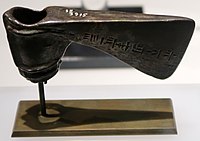Untash-Napirisha was king of Elam (in present-day southwest Iran) during the Middle Elamite period, circa 1300 BCE. He was the son of the previous Elamite king, Humban-Numena and of a daughter[4] (or granddaughter)[2] of Kurigalzu.[4] He was named after Napirisha, an Elamite deity.
| Untash-Napirisha | |
|---|---|
| King of Elam | |
 Statue of Napir-Asu, wife of Untash-Napirisha in Louvre Museum Inscription: "I, Napir-Asu, wife of Untash-Napirisha. He who would seize my statue, who would smash it, who would destroy its inscription, who would erase my name, may he be smitten by the curse of Napirisha, of Kiririsha, and of Inshushinka, that his name shall become extinct, that his offspring be barren, that the forces of Beltiya, the great goddess, shall sweep down on him. This is Napir-Asu's offering."[1] | |
| Reign | circa 1300 BC |
| Predecessor | Humban-Numena |
| Successor | Kidin-Hutran |
| Father | Humban-Numena |
| Mother | Daughter (or granddaughter)[2] of Kurigalzu[3] |
He founded and built extensively a new city, Dur-Untash, 40 km SE of Susa, modern Chogha Zanbil. He built extensively in this city, and its main temple, the famous Ziggurat, still stands there.[5] Although construction in this religious city complex abruptly ended after Untash-Napirisha's death, the site was not abandoned, but continued to be occupied until it was destroyed by the Assyrian king Ashurbanipal in 640 BC.
Untash-Napirirsha also left numerous building inscriptions for more than 50 temples and buildings, either built or renovated during his reign, in Chogha Zanbil, Susa, Choga Gotvand and other places.[6]
He dedicated a statue of the god Immiriya in Chogha Zanbil to his father-in-law, the Babylonian Burnaburiash.[a][8][9] A later Elamite letter from Berlin (Pergamon Museum VAT17020) mentions that he was married to “the daughter of Burna-buriash (a Babylonian king) and they had a son (and the future Elamite king) Kidin-hudurdish (Hutran)".[10] If this was the Babylonian king Burna-Buriash II, then the reign of Untash-Napirisha could be dated ca. 1340–1300 BC. However, some scholars consider a different model for the synchronism between the Kassite dynasty in Babylon and the Elamite kings, and suggest that the mentioned Burna-buriash was a later prince, and that the reign of Untash-Napirisha could be dated c. 1275–1240 BC; see, for example The Berlin Letter, Middle Elamite Chronology and Sutruk-Nahhunte I's Genealogy.[11]
-
Axe bearing the name of the king Untash-Napirisha.
-
Axe inscribed with the name of King Untash-Napirisha
-
The Ziggurat at Chogha Zanbil was built by Untash-Napirisha.
-
Fish-tailed deity holding snakes. Stele of Untash Napirisha, sandstone, ca. 1340–1300 BC, brought from Tchoga Zanbil to Susa in the 12th century BC.[12]
-
Plaque with inscription "Palace of Untash-Napirisha" from Chogha Zanbil
Notes
edit- ^ In the dedication, the part of the text mentioning the Babylonian king is damaged. In François Vallat's opinion, shared by Daniel T. Potts, […-l]i-ia-áš should be read as [Bur-na]-bur-ia-áš; E. Reiner prefers a geographical interpretation, proposing [tup-l]i-ia-áš; according to other historians, the damaged text should be restored as [kaš-ti-l]i-ia-áš, actually referring to Kashtiliash IV.[7]
References
edit- ^ The Archaeology of Elam: Formation and Transformation of an Ancient Iranian State. Daniel T. Potts, 2nd edition
- ^ a b Basello, Gian Pietro; Álvarez-Mon, Javier; Wicks, Yasmina (2018). The Elamite World. Taylor & Francis. ISBN 9781317329831.
- ^ Podany, Amanda H. (2022). Weavers, Scribes, and Kings A New History of the Ancient Near East. Oxford University Press. p. 383. ISBN 9780190059040.
That king, Untash- Napirisha, was Burna-Buriash's first cousin: both were grandsons of a Babylonian king named Kurigalzu
- ^ a b Matthews, Roger; Fazeli Nashli, Hassan (2022). The Archaeology of Iran from the Palaeolithic to the Achaemenid Empire. Taylor & Francis. ISBN 9781000570915.
The most significant king of the Igihalkid dynasty was Untash-Napirisha (c. 1340–1300 BC) who married a daughter of the Kassite king Burna-Buriash II and was himself the son of a Kassite princess.
- ^ Elizabeth Carter, Matthew W. Stolpe. Elam: Surveys of Political History and Archaeology p. 37
- ^ Potts, Daniel T. (1999). The Archaeology of Elam. Cambridge University Press. pp. 213–216.
- ^ Quintana, Enrique (2011). "Filiacion y acceso al trono en Elam (2ª Mitad II milenio a.c.)". Revue d'assyriologie et d'archéologie orientale. 104: 45–63. doi:10.3917/assy.104.0045.
- ^ Potts, Daniel T. (April 2006). "Elamites and Kassites in the Persian Gulf". Journal of Near Eastern Studies. 65 (2). University of Chicago Press: 115. doi:10.1086/504986. S2CID 162371671.
- ^ Potts, Daniel T. (2014). Elamite Monumentality and Architectural Scale - Lessons from Suda and Choga Zanbil. p. 29.
- ^ Potts, Daniel T. (1999). The Archaeology of Elam. Cambridge University Press. p. 208.
- ^ Goldberg, Jeremy (24 May 2004). "The Berlin Letter, Middle Elamite Chronology and Sutruk-Nahhunte I's Genealogy". Iranica Antiqua. 39: 33–42. doi:10.2143/IA.39.0.503891 – via www.academia.edu.
- ^ "Stèle du roi Untash-Napirisha, "roi d'Anzan et de Suse"". 2020.



![Fish-tailed deity holding snakes. Stele of Untash Napirisha, sandstone, ca. 1340–1300 BC, brought from Tchoga Zanbil to Susa in the 12th century BC.[12]](http://upload.wikimedia.org/wikipedia/commons/thumb/c/c4/Untash_Napirisha_stele_Louvre_Sb12.jpg/131px-Untash_Napirisha_stele_Louvre_Sb12.jpg)
